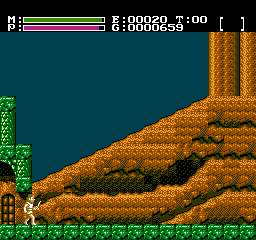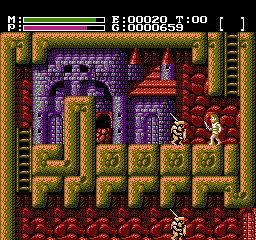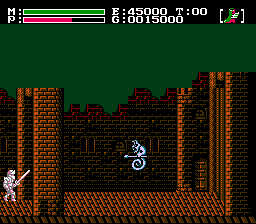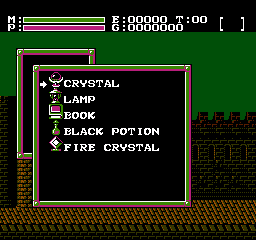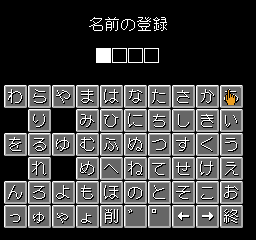Faxanadu
| Faxanadu |
|---|
|
Developer: Hudson Soft
|
Faxanadu is a side-scrolling action RPG, in a somewhat similar vein to Wizards and Warriors. It is part of the Dragon Slayer series in Japan, of which very few games have seen any sort of overseas release.
Contents
Sub-Pages
| Notes |
| Bugs |
Unused Rooms
These two are duplicates of rooms which are actually used, although they do not contain any sprites. The second room actually appears five times in total.
An alternative entrance to the final dungeon of the game. This one was probably scrapped because it is quite easy to just jump over the obstacle in the middle or because the lower level has no floor.
An extension of the King Grieve boss room. According to the room data, the left edge is supposed to lead to the used room (although it does not work properly), which suggests that the boss fight was originally planned to span over multiple screens.
Unused Enemies
Offset $2CC contains the IDs of the sprites visible on the screen. Interestingly, there are six enemies in the ROM which never actually appear in-game. The IDs of these enemies are 18, 29, 36, 39, 43, 70 (all decimal).
| Used | Unused |
|---|---|
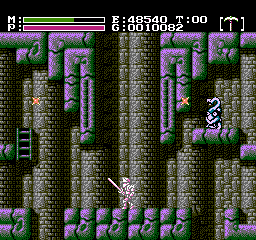
|

|
The unused tentacle enemy is a variant of an enemy which can be found once in the final dungeon. The behaviour of the enemy is almost identical, except that the projectile is shot on a higher Y axis.
Unused NPCs
Additionally, there are two defined NPCs who never appear in-game. The first one is a lovely blue lady with ID 53, and the other is a child with ID 54.
Unused Character Portraits
The game contains two unused character portraits. They blink just as often as the other ones though.
Unused Objects
The game contains five unused items, most of which are taken from the PC-8801 game Xanadu of which Faxanadu is a spinoff of. Since none of these items do anything when equipped, it is unknown whether they would have functioned similar to their Xanadu counterparts, none of which would make sense in the released game (Black Potion did 50% damage to the player and restored their Karma, Lamp lit dark rooms temporarily, the Fire Crystal moved the player up one level, and the Crystal and Book/Bible were stat boosters; none of these mechanics are used in Faxanadu); they may be remnants from an earlier design.
The item IDs are $0b, $0c, $0e, $11 and $15.
Unused Text
The game's script is mostly ASCII-encoded and starts at ROM offset $34310.
Hello. Could I help you with anything. What would you like?
Anything else?
Come back again.
You don't have a key.
Do you want to hear it once more?
A variety of unused and possibly early conversations with shopkeepers. Some of these lines suggest that ealier in development it was possible to buy or sell multiple items without going through the entire dialog over and over again.
You need a key.
You need a different key.
Looks like some doors were quite picky earlier in development.
Look for Wing Boots.
This line is located around the text for Forepaw.
Magics have individual powers.
A generic line which is part of an unused dialog. The dialog contains a second line which is used and is about how magic can be used for justice or destruction. The game would have selected this line over the other one when the player owns the Thunder spell.
| Unused | Used |
|---|---|
Don't rely on your magic power only during the final fight against the Dwarfs. You can wear the Battle Helmet and Battle Suit only when you have the Dragon Slayer. You will not be able to return us the Dragon Slayer until we have true peace here. |
Don't rely on your magic power alone during the last fight against the Dwarfs. You can wear the Battle Helmet and Battle Suit only when you have the Dragon Slayer. You will not be able to return us the Dragon Slayer until we have true peace here. This ring will open the door to Dartmoor. Take it with you. |
A near duplicate of the line the Guru says when giving the player the Ring of Dworf [sic]. It has slightly different wording in the beginning and is missing the last two sentences, suggesting that the Ring of Dworf originally might have been gotten elsewhere.
There is the Castle of Fraternal down below the town of Dartmoor.
You need the Demon's Ring to get into the fortress of Zenis.
Another unused dialog, but this time, both possible lines go unused. The game would have selected the first line when the player does not own the Dragon Slayer, otherwise it would have shown the second one. The Castle of Fraternal is the second to last dungeon where the Dragon Slayer is normally obtained. The Fortess of Zenis is the name of the final dungeon, though it is only called that in the game's manual and not in the actual game.
Regional Differences
| To do: Compare the different US revisions. It seems to mainly affect the way passwords work. |
Title Screen
| Japan | USA | Europe |
|---|---|---|

|
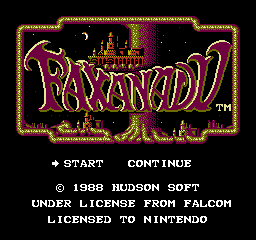
|
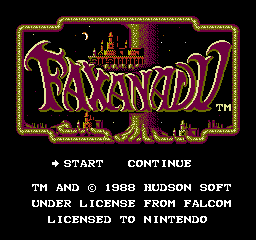
|
The game selections were rearranged to fit the new copyright info added in the international versions.
Password
| Japan | USA (REV0) | USA (REV1)/Europe |
|---|---|---|
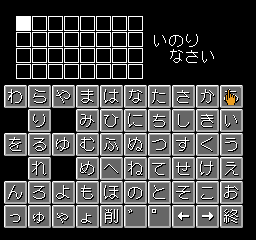
|
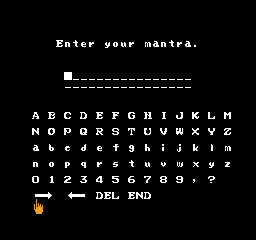
|

|
The Japanese version uses a large 16x16 font type, which was reduced to a smaller 8x8 type for the English version. A later revision of the North American version changed the font type used in the game and this was the version that was released in Europe. Additionally, passwords are referred to as prayers in the Japanese version and mantras in the English version.
Name Registration
The Japanese version has an exclusive name entry feature. At the start of the game, the player must register their character's name, which can consist of up to four characters. The name will be used throughout the script and will also affect what kind of passwords are generated.
Dialogue Font
| Japan | USA (REV0) | USA (REV1)/Europe |
|---|---|---|

|
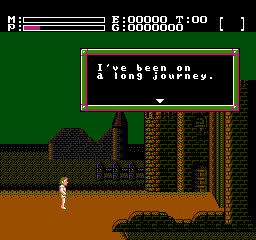
|

|
Much like the password and name entry, the Japanese version used a 16x16 block font for dialogues. In the initial US version, this was changed to a variant of the Japanese 8x8 block font used for items, but with lowercase letters and some punctuation characters added, then changed to a more simplistic font in US Revision 1 and European release.
Religious Imagery
| Japan | International |
|---|---|
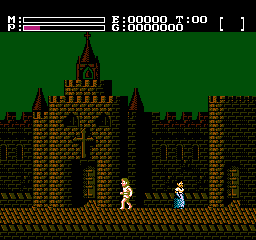
|

|
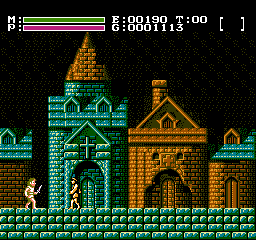
|
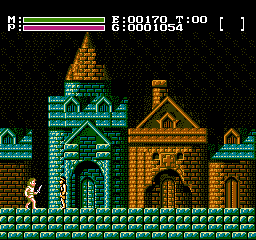
|
The crosses on churches were removed in the international versions.
| Japan | International |
|---|---|
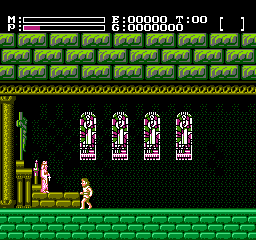 |
 |
Inside the churches, the crucifix and rosary was removed.
| Japan | International |
|---|---|
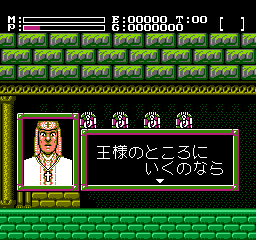 |
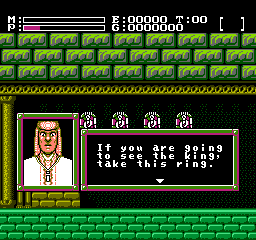 |
The priests are known as gurus in the international versions, and their portrait was altered as well.
The Dragon Slayer series
| |
|---|---|
| PC-88 | Dragon Slayer |
| MSX | Dragon Slayer IV: DrasleFamily |
| MSX2 | Dragon Slayer IV: DrasleFamily |
| NES | Legacy of the Wizard • Faxanadu • Romancia |
| SNES | Dragon Slayer: Eiyuu Densetsu • Lord Monarch |
| Genesis | Lord Monarch: Tokoton Sentou Densetsu |
| TurboGrafx CD | Dragon Slayer: The Legend of Heroes • Kaze no Densetsu Xanadu • Kaze no Densetsu Xanadu II |
- Pages missing developer references
- Games developed by Hudson Soft
- Pages missing publisher references
- Games published by Hudson Soft
- Games published by Nintendo
- NES games
- Pages missing date references
- Games released in 1987
- Games released in November
- Games released on November 26
- Games with unused areas
- Games with unused enemies
- Games with unused graphics
- Games with unused items
- Games with unused text
- Games with regional differences
- Games with revisional differences
- To do
- Dragon Slayer series
Cleanup > Pages missing date references
Cleanup > Pages missing developer references
Cleanup > Pages missing publisher references
Cleanup > To do
Games > Games by content > Games with regional differences
Games > Games by content > Games with revisional differences
Games > Games by content > Games with unused areas
Games > Games by content > Games with unused enemies
Games > Games by content > Games with unused graphics
Games > Games by content > Games with unused items
Games > Games by content > Games with unused text
Games > Games by developer > Games developed by Konami > Games developed by Hudson Soft
Games > Games by platform
Games > Games by publisher > Games published by Konami > Games published by Hudson Soft
Games > Games by publisher > Games published by Nintendo
Games > Games by release date > Games released in 1987
Games > Games by release date > Games released in November
Games > Games by release date > Games released in November > Games released on November 26
Games > Games by series > Dragon Slayer series
The Cutting Room Floor > Unimportant Awards > NES games
